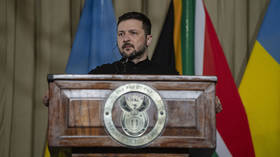Bad weather, human error & technical fault: Main versions behind fatal Flydubai FZ981 flight
The Russian Investigative Committee is studying two possible versions of why the Flydubai flight FZ981 crashed in the southern city of Rostov-on-Don, that killed all 62 people on board, including human error amid severe weather conditions and a possible technical fault.
LIVE UPDATES: Flydubai flight FZ981 crash
An ad hoc committee, set up by the Interstate Aviation Committee, is investigating the exact circumstances of the tragedy. Both black boxes have been recovered and are now being studied, officials from the Russian transport ministry reported.
“Different versions of the incident are being investigated, including crew error, technical failure, bad weather and other factors,” the Investigative Committee’s chief Vladimir Markin said.
“We don't know all the details but we know that the authorities are coordinating to better understand the circumstances around the accident,” Flydubai CEO Ghaith al-Ghaith said at a press conference in Dubai on Saturday.
Flight 981 followed its planned route from Dubai, until the aircraft reached its final destination, Rostov-on-Don. The plane tried to land at around 10:40pm GMT, but the first attempt was aborted. Then, according to radar information, the pilots flew in a holding pattern over the city, having circled the airport ten times before attempting to land for a second time.
Poor weather conditions
Flight dispatchers warned the pilots of the Flydubai flight FZ981 repeatedly that the weather conditions were poor, but not critical, the head of Russian Hydrometeorology center’s situation room Yuri Varakin told RT. According to an alleged recording between the captain and the control tower, traffic controllers reported shower rain and “moderate” visibility prior to fatal landing attempt.
However, the final decision on whether to land or not in heavy rain and gusty wind conditions is made by the pilot-in-command, Russia’s Federal Air Transport Agency (Rosaviatsia) explained. Some experts suggest that the plane could have hit an air pocket which led to the crash.
“The plane was descending and then suddenly dived down. Experts say this was an air pocket that dragged the plane to the left of the runway center. And the plane debris were scattered to the left as well,” Rostov region governor Vasily Golubev suggested.
The weather was not “extremely” difficult to land an aircraft, Aeroflot pilot Ivan Trukhanov told RT, pointing however that crosswinds and turbulence at a low altitude could have driven the plane “out of control” where the pilot could do nothing to save the aircraft.
It is unusual for an aircraft to circle for two extra hours, while other planes were diverting much sooner or landing safely, independent aviation analyst Alex Macheras told RT, adding however that it is always up to the pilot to decide whether to make another landing attempt or divert.
[Update] This chart shows the approach method and path the pilots on #FZ981 used to assist them in landing. pic.twitter.com/N2ejhfDfj5
— Brendan Grainger (@S118869) March 19, 2016
“There wasn’t great weather last night in the area... nothing too dangerous that would for example close the airport, so the airport was within its rights to be taking the arriving aircraft...,” Macheras said.
“And Rostov isn’t the easiest airport to land at on an ordinary day,” he added. “Pilots and flight crew are advised on their charts when landing at the airport to expect severe turbulence and possible windshear in the final moments before touchdown.”
Human error
Two other planes that were scheduled to land before the FZ981 flight but were redirected to the airport in the city of Krasnodar due to bad weather. The Flydubai pilots, who had enough fuel to reroute, could have yet decided to sit down in Rostov since landings in non-designated airports are usually not welcomed by the airline management, veteran pilot Oleg Smirnov told TASS.
There are several facts that investigators believe could have increased the chance of human error. Some observers suggested that the crew could have been tired after circling over the city for several hours, while others noted that it may have been the first time the crew has been to the airport in Rostov-on-Don.
On the other hand, both pilots were well-experienced and they have received the weather warning in advance, Ghaith al-Ghaith said following the first major accident for Flydubai.
Technical fault
The investigation also does not rule out the possibility of a technical fault. While the weather conditions were bad, some noted that the way the plane came down also seemed “strange,” pointing to a possible technical fault.
“The Boeing fell vertically, practically nose-diving into the ground,” a source at the emergency services said, noting that the aircraft literally disintegrated upon impact with small fragments scattered within a relatively small radius.
The flight data by FlightRadar “suggests that this aircarft was trying to take off again, in other words aborting the landing for the second time,” security expert Charles Shoebridge told RT. “As the aircraft tried to climb back into the sky, it fell violently and crashed.”
“It has been confirmed that this descent was at a very sharp angle... but it does seem strange that the plane should almost literally fall out of the sky,” Shoebridge added, noting that “it may suggest some degree of mechanical defect.”
Shoebridge however also does not rule out the tragedy could be a result of a human error after long journey and two hours of holding pattern, or even a mistake by the air traffic controllers “who decided to allow this to continue despite the weather.”
FIRST VIDEO: Moment #FlyDubai Boeing #FZ981 crashes in Russia killing everyone on board https://t.co/oxOzGehVpvpic.twitter.com/08P6TFXX7r
— RT Play (@rt_play) March 19, 2016
The flight recorders however remained in a "normal condition,” and are expected to shed light on the exact details of the fatal crash.
READ MORE: RT report from the Flydubai crash site in southern Russia
Meanwhile the Rostov-on-Don airport remains closed with all inbound flights getting rerouted to Krasnodar, as the search and recovery operations will continue until at least Sunday morning, RT’s Roman Kosarev reported. As soon as the recovery operation is over, Russian experts along with foreign ones will proceed to establishing the cause of the crash.
While the preliminary information from the flight data recorder and the flight voice recorder can be extracted quite quickly, the “meaning of the data will take a little bit over to summarize,” aviation security expert Richard Bloom told RT.
Flight radar route of #FZ981 that crashed on landing https://t.co/bfeuoVdREnpic.twitter.com/QFVm3WKyX6
— RT (@RT_com) March 19, 2016
“What we need to do is collect data environmental factors...and then technical and mechanical aspects of the aircraft, and then various aspects of the people flying the plane – psychological, training and otherwise,” Bloom explained. “You put all of that together along with the safety record of the aircraft, safety records of the airlines. So you have multi-model data. You analyse it with multiple means, gradually you come up with an appropriate conclusion.”
“What might have happened is that a perfectly good aircraft with perfectly well trained people have crashed because of an unexpected meteorological anomaly. Maybe a very very strong gust of wind might have helped the aircraft go off course.”
RT encourages people who can shed light on the situation to write to flydubaigate@rttv.ru and tell us their stories.














